Sustainable Construction: Waste Management and Wind Energy
VerifiedAdded on 2021/05/31
|21
|4803
|40
Report
AI Summary
This report delves into the realm of sustainable construction, focusing on three key areas: construction and demolition waste management, wind energy integration, and green building practices. The waste management section examines the hierarchy of waste, recycling methods, and the analysis of construction and demolition waste management in the UK, along with its merits, demerits, opportunities, and threats. The report also explores the strengths, weaknesses, opportunities, and threats associated with wind energy. Finally, it addresses green building concepts, including its environmental, economic, and social benefits, alongside its weaknesses, opportunities, and threats. The report emphasizes the importance of waste minimization, resource management, and the integration of renewable energy sources to create a more sustainable and environmentally friendly construction industry. The report also includes SWOT analysis of each topic to help understand the current situation and develop suitable strategies.
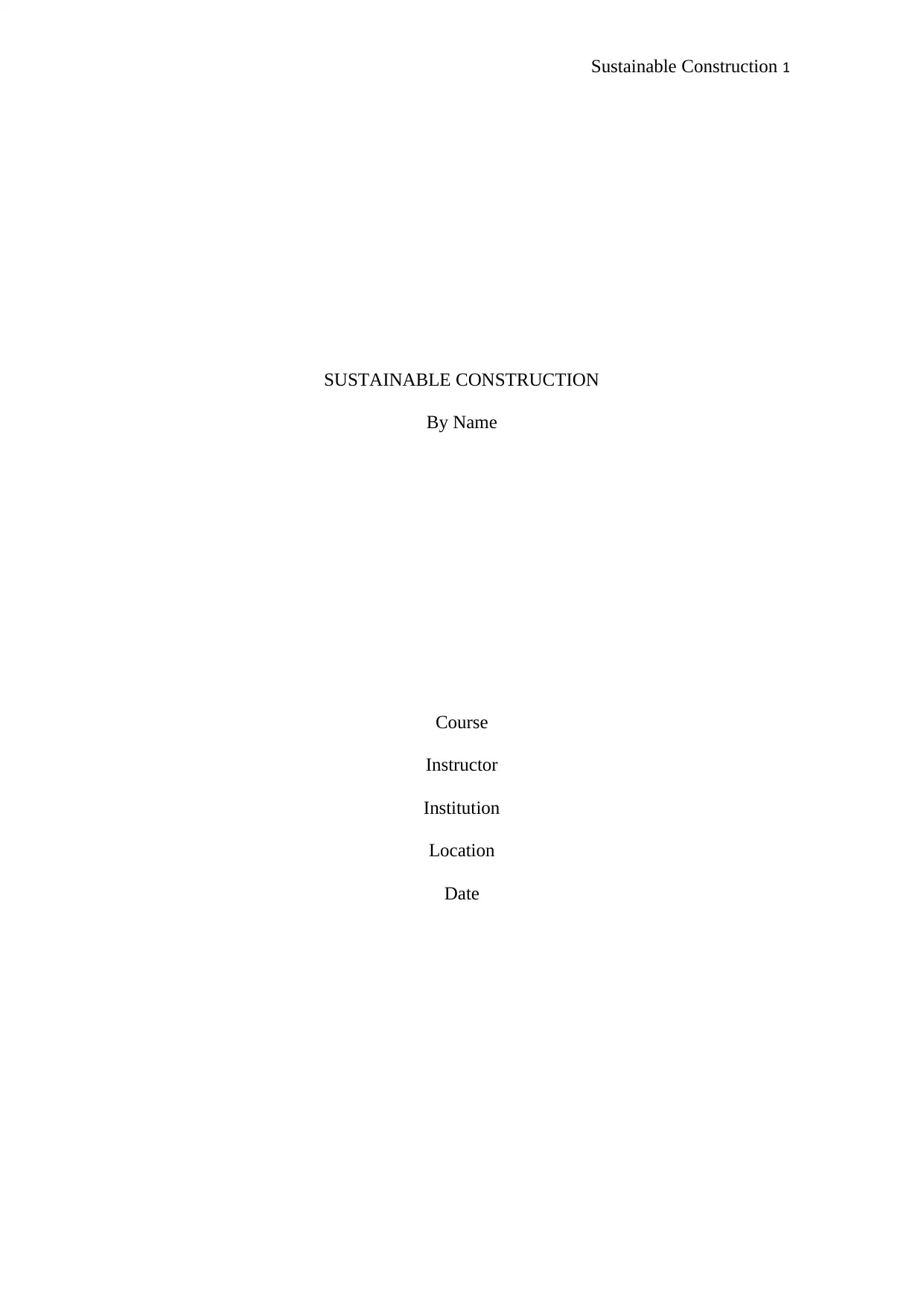
Sustainable Construction 1
SUSTAINABLE CONSTRUCTION
By Name
Course
Instructor
Institution
Location
Date
SUSTAINABLE CONSTRUCTION
By Name
Course
Instructor
Institution
Location
Date
Paraphrase This Document
Need a fresh take? Get an instant paraphrase of this document with our AI Paraphraser
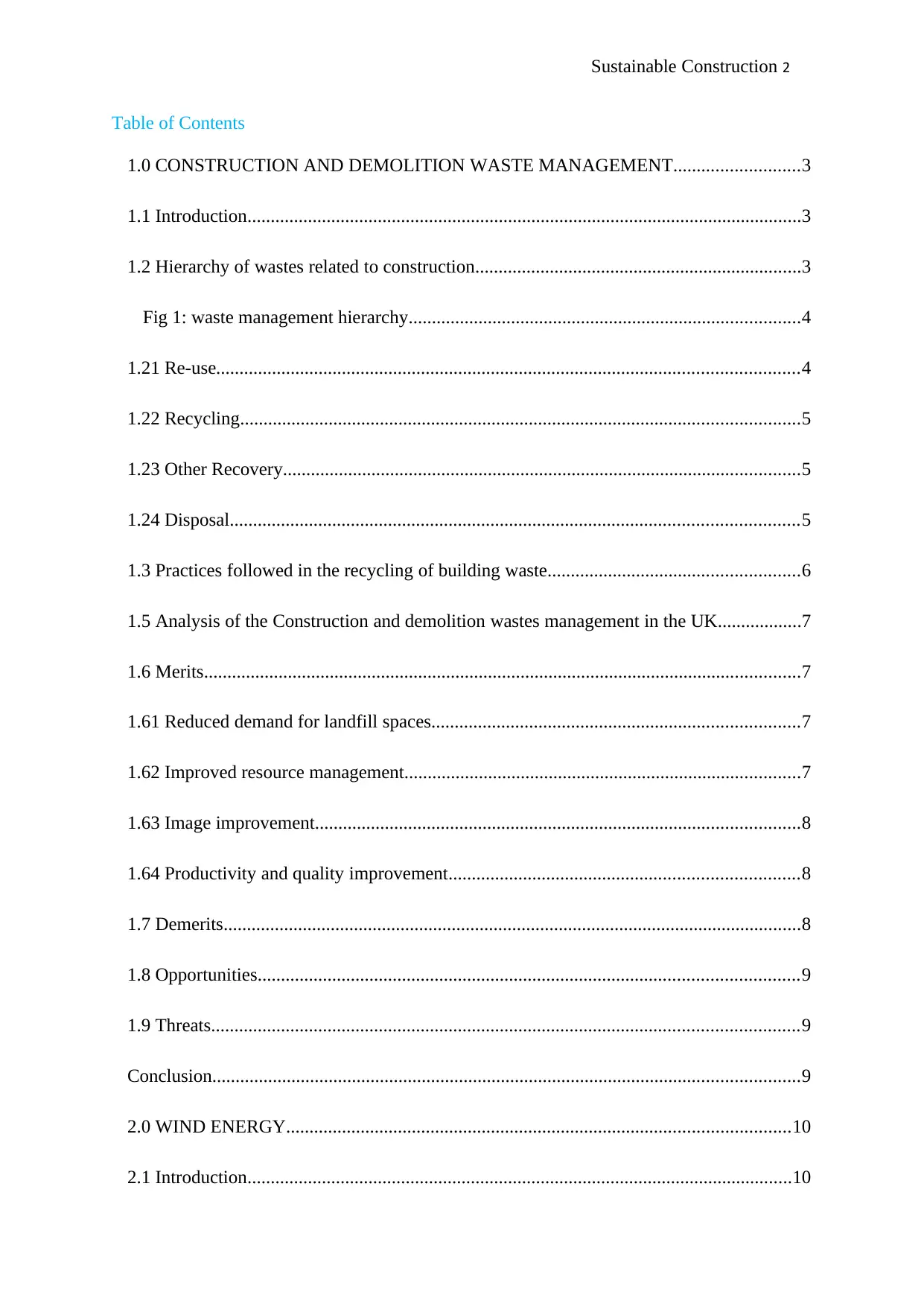
Sustainable Construction 2
Table of Contents
1.0 CONSTRUCTION AND DEMOLITION WASTE MANAGEMENT...........................3
1.1 Introduction.......................................................................................................................3
1.2 Hierarchy of wastes related to construction......................................................................3
Fig 1: waste management hierarchy....................................................................................4
1.21 Re-use.............................................................................................................................4
1.22 Recycling........................................................................................................................5
1.23 Other Recovery...............................................................................................................5
1.24 Disposal..........................................................................................................................5
1.3 Practices followed in the recycling of building waste......................................................6
1.5 Analysis of the Construction and demolition wastes management in the UK..................7
1.6 Merits................................................................................................................................7
1.61 Reduced demand for landfill spaces...............................................................................7
1.62 Improved resource management.....................................................................................7
1.63 Image improvement........................................................................................................8
1.64 Productivity and quality improvement...........................................................................8
1.7 Demerits............................................................................................................................8
1.8 Opportunities....................................................................................................................9
1.9 Threats..............................................................................................................................9
Conclusion..............................................................................................................................9
2.0 WIND ENERGY............................................................................................................10
2.1 Introduction.....................................................................................................................10
Table of Contents
1.0 CONSTRUCTION AND DEMOLITION WASTE MANAGEMENT...........................3
1.1 Introduction.......................................................................................................................3
1.2 Hierarchy of wastes related to construction......................................................................3
Fig 1: waste management hierarchy....................................................................................4
1.21 Re-use.............................................................................................................................4
1.22 Recycling........................................................................................................................5
1.23 Other Recovery...............................................................................................................5
1.24 Disposal..........................................................................................................................5
1.3 Practices followed in the recycling of building waste......................................................6
1.5 Analysis of the Construction and demolition wastes management in the UK..................7
1.6 Merits................................................................................................................................7
1.61 Reduced demand for landfill spaces...............................................................................7
1.62 Improved resource management.....................................................................................7
1.63 Image improvement........................................................................................................8
1.64 Productivity and quality improvement...........................................................................8
1.7 Demerits............................................................................................................................8
1.8 Opportunities....................................................................................................................9
1.9 Threats..............................................................................................................................9
Conclusion..............................................................................................................................9
2.0 WIND ENERGY............................................................................................................10
2.1 Introduction.....................................................................................................................10
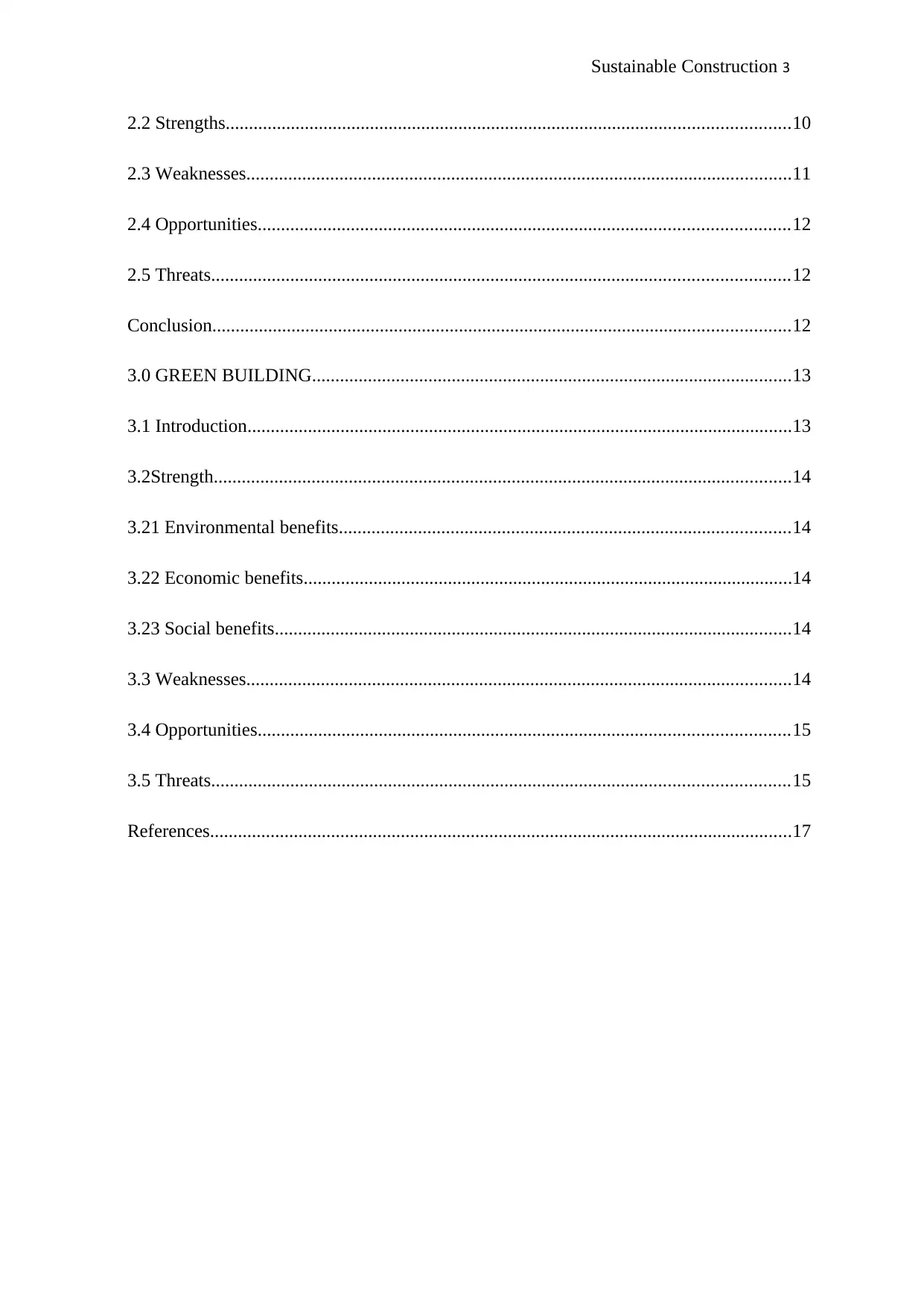
Sustainable Construction 3
2.2 Strengths.........................................................................................................................10
2.3 Weaknesses.....................................................................................................................11
2.4 Opportunities..................................................................................................................12
2.5 Threats............................................................................................................................12
Conclusion............................................................................................................................12
3.0 GREEN BUILDING.......................................................................................................13
3.1 Introduction.....................................................................................................................13
3.2Strength............................................................................................................................14
3.21 Environmental benefits.................................................................................................14
3.22 Economic benefits.........................................................................................................14
3.23 Social benefits...............................................................................................................14
3.3 Weaknesses.....................................................................................................................14
3.4 Opportunities..................................................................................................................15
3.5 Threats............................................................................................................................15
References.............................................................................................................................17
2.2 Strengths.........................................................................................................................10
2.3 Weaknesses.....................................................................................................................11
2.4 Opportunities..................................................................................................................12
2.5 Threats............................................................................................................................12
Conclusion............................................................................................................................12
3.0 GREEN BUILDING.......................................................................................................13
3.1 Introduction.....................................................................................................................13
3.2Strength............................................................................................................................14
3.21 Environmental benefits.................................................................................................14
3.22 Economic benefits.........................................................................................................14
3.23 Social benefits...............................................................................................................14
3.3 Weaknesses.....................................................................................................................14
3.4 Opportunities..................................................................................................................15
3.5 Threats............................................................................................................................15
References.............................................................................................................................17
⊘ This is a preview!⊘
Do you want full access?
Subscribe today to unlock all pages.

Trusted by 1+ million students worldwide
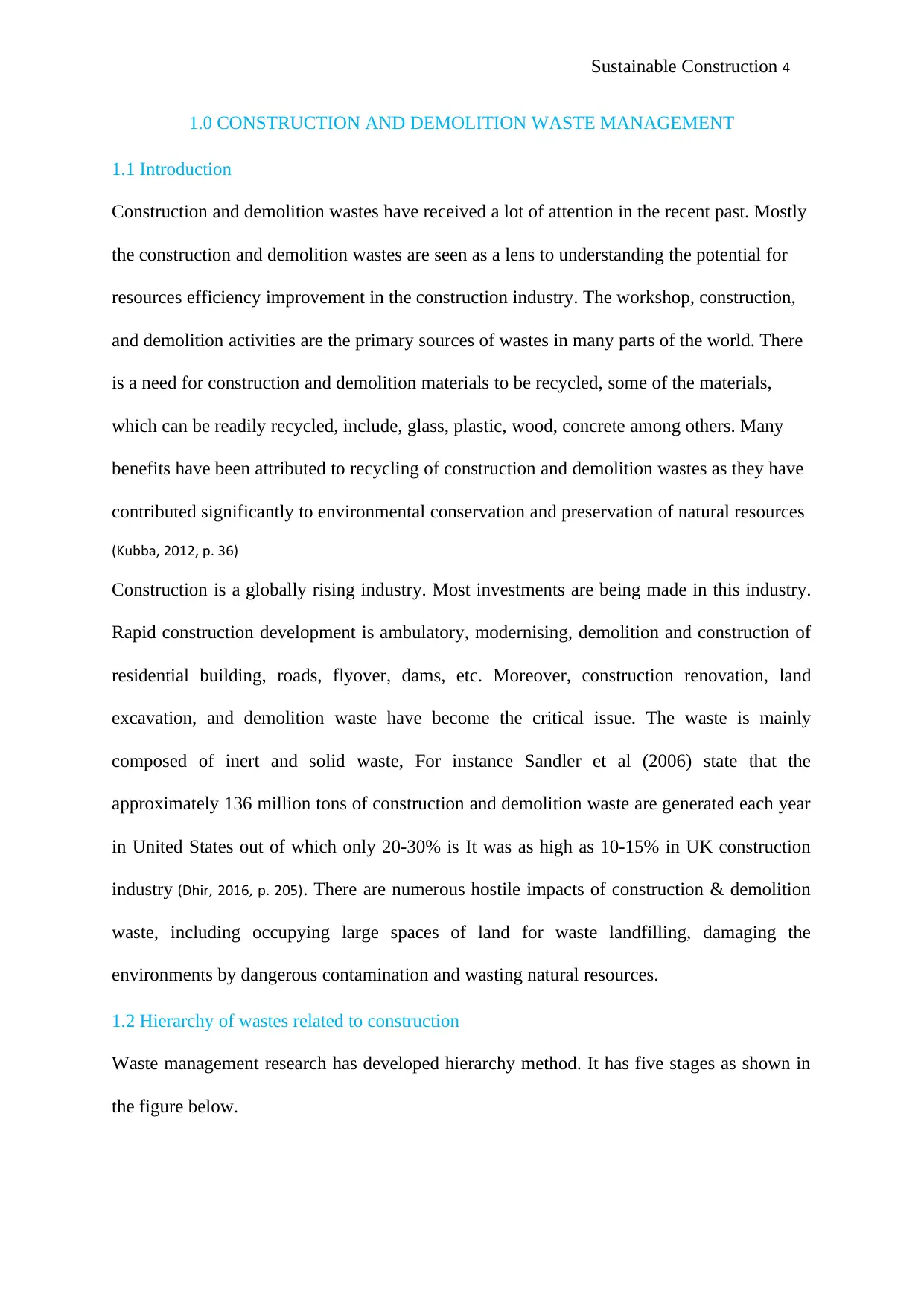
Sustainable Construction 4
1.0 CONSTRUCTION AND DEMOLITION WASTE MANAGEMENT
1.1 Introduction
Construction and demolition wastes have received a lot of attention in the recent past. Mostly
the construction and demolition wastes are seen as a lens to understanding the potential for
resources efficiency improvement in the construction industry. The workshop, construction,
and demolition activities are the primary sources of wastes in many parts of the world. There
is a need for construction and demolition materials to be recycled, some of the materials,
which can be readily recycled, include, glass, plastic, wood, concrete among others. Many
benefits have been attributed to recycling of construction and demolition wastes as they have
contributed significantly to environmental conservation and preservation of natural resources
(Kubba, 2012, p. 36)
Construction is a globally rising industry. Most investments are being made in this industry.
Rapid construction development is ambulatory, modernising, demolition and construction of
residential building, roads, flyover, dams, etc. Moreover, construction renovation, land
excavation, and demolition waste have become the critical issue. The waste is mainly
composed of inert and solid waste, For instance Sandler et al (2006) state that the
approximately 136 million tons of construction and demolition waste are generated each year
in United States out of which only 20-30% is It was as high as 10-15% in UK construction
industry (Dhir, 2016, p. 205). There are numerous hostile impacts of construction & demolition
waste, including occupying large spaces of land for waste landfilling, damaging the
environments by dangerous contamination and wasting natural resources.
1.2 Hierarchy of wastes related to construction
Waste management research has developed hierarchy method. It has five stages as shown in
the figure below.
1.0 CONSTRUCTION AND DEMOLITION WASTE MANAGEMENT
1.1 Introduction
Construction and demolition wastes have received a lot of attention in the recent past. Mostly
the construction and demolition wastes are seen as a lens to understanding the potential for
resources efficiency improvement in the construction industry. The workshop, construction,
and demolition activities are the primary sources of wastes in many parts of the world. There
is a need for construction and demolition materials to be recycled, some of the materials,
which can be readily recycled, include, glass, plastic, wood, concrete among others. Many
benefits have been attributed to recycling of construction and demolition wastes as they have
contributed significantly to environmental conservation and preservation of natural resources
(Kubba, 2012, p. 36)
Construction is a globally rising industry. Most investments are being made in this industry.
Rapid construction development is ambulatory, modernising, demolition and construction of
residential building, roads, flyover, dams, etc. Moreover, construction renovation, land
excavation, and demolition waste have become the critical issue. The waste is mainly
composed of inert and solid waste, For instance Sandler et al (2006) state that the
approximately 136 million tons of construction and demolition waste are generated each year
in United States out of which only 20-30% is It was as high as 10-15% in UK construction
industry (Dhir, 2016, p. 205). There are numerous hostile impacts of construction & demolition
waste, including occupying large spaces of land for waste landfilling, damaging the
environments by dangerous contamination and wasting natural resources.
1.2 Hierarchy of wastes related to construction
Waste management research has developed hierarchy method. It has five stages as shown in
the figure below.
Paraphrase This Document
Need a fresh take? Get an instant paraphrase of this document with our AI Paraphraser
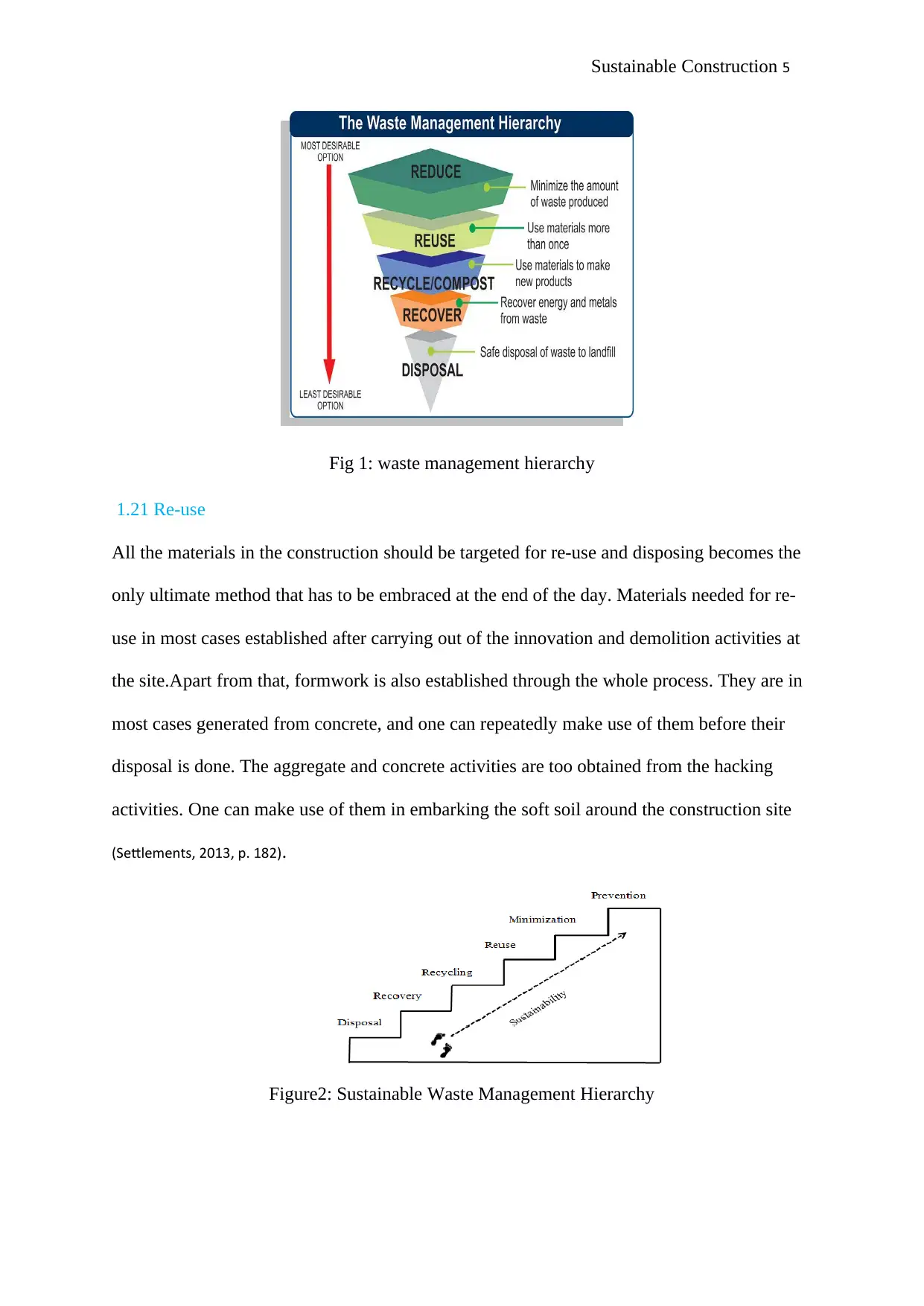
Sustainable Construction 5
Fig 1: waste management hierarchy
1.21 Re-use
All the materials in the construction should be targeted for re-use and disposing becomes the
only ultimate method that has to be embraced at the end of the day. Materials needed for re-
use in most cases established after carrying out of the innovation and demolition activities at
the site.Apart from that, formwork is also established through the whole process. They are in
most cases generated from concrete, and one can repeatedly make use of them before their
disposal is done. The aggregate and concrete activities are too obtained from the hacking
activities. One can make use of them in embarking the soft soil around the construction site
(Settlements, 2013, p. 182).
Figure2: Sustainable Waste Management Hierarchy
Fig 1: waste management hierarchy
1.21 Re-use
All the materials in the construction should be targeted for re-use and disposing becomes the
only ultimate method that has to be embraced at the end of the day. Materials needed for re-
use in most cases established after carrying out of the innovation and demolition activities at
the site.Apart from that, formwork is also established through the whole process. They are in
most cases generated from concrete, and one can repeatedly make use of them before their
disposal is done. The aggregate and concrete activities are too obtained from the hacking
activities. One can make use of them in embarking the soft soil around the construction site
(Settlements, 2013, p. 182).
Figure2: Sustainable Waste Management Hierarchy
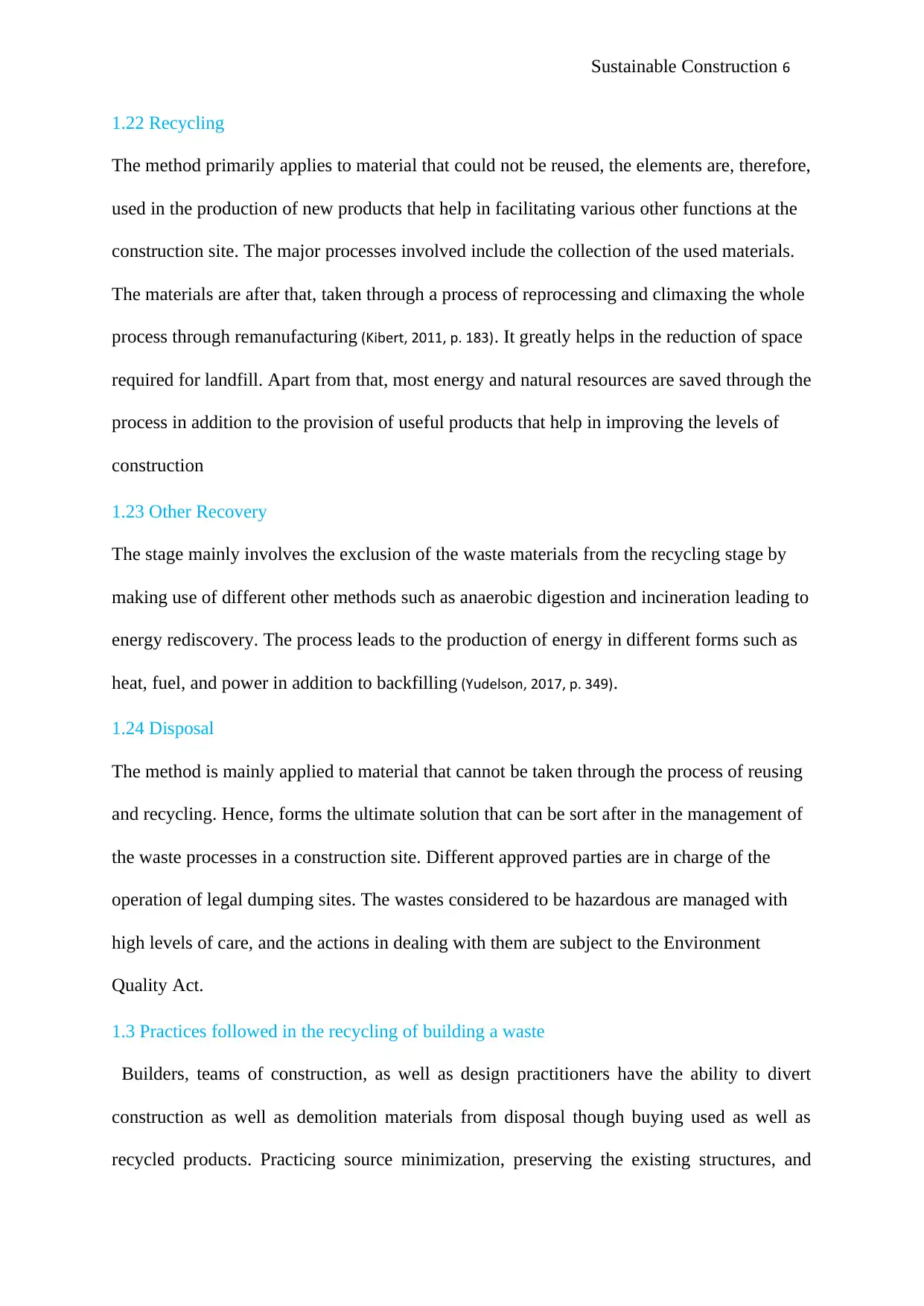
Sustainable Construction 6
1.22 Recycling
The method primarily applies to material that could not be reused, the elements are, therefore,
used in the production of new products that help in facilitating various other functions at the
construction site. The major processes involved include the collection of the used materials.
The materials are after that, taken through a process of reprocessing and climaxing the whole
process through remanufacturing (Kibert, 2011, p. 183). It greatly helps in the reduction of space
required for landfill. Apart from that, most energy and natural resources are saved through the
process in addition to the provision of useful products that help in improving the levels of
construction
1.23 Other Recovery
The stage mainly involves the exclusion of the waste materials from the recycling stage by
making use of different other methods such as anaerobic digestion and incineration leading to
energy rediscovery. The process leads to the production of energy in different forms such as
heat, fuel, and power in addition to backfilling (Yudelson, 2017, p. 349).
1.24 Disposal
The method is mainly applied to material that cannot be taken through the process of reusing
and recycling. Hence, forms the ultimate solution that can be sort after in the management of
the waste processes in a construction site. Different approved parties are in charge of the
operation of legal dumping sites. The wastes considered to be hazardous are managed with
high levels of care, and the actions in dealing with them are subject to the Environment
Quality Act.
1.3 Practices followed in the recycling of building a waste
Builders, teams of construction, as well as design practitioners have the ability to divert
construction as well as demolition materials from disposal though buying used as well as
recycled products. Practicing source minimization, preserving the existing structures, and
1.22 Recycling
The method primarily applies to material that could not be reused, the elements are, therefore,
used in the production of new products that help in facilitating various other functions at the
construction site. The major processes involved include the collection of the used materials.
The materials are after that, taken through a process of reprocessing and climaxing the whole
process through remanufacturing (Kibert, 2011, p. 183). It greatly helps in the reduction of space
required for landfill. Apart from that, most energy and natural resources are saved through the
process in addition to the provision of useful products that help in improving the levels of
construction
1.23 Other Recovery
The stage mainly involves the exclusion of the waste materials from the recycling stage by
making use of different other methods such as anaerobic digestion and incineration leading to
energy rediscovery. The process leads to the production of energy in different forms such as
heat, fuel, and power in addition to backfilling (Yudelson, 2017, p. 349).
1.24 Disposal
The method is mainly applied to material that cannot be taken through the process of reusing
and recycling. Hence, forms the ultimate solution that can be sort after in the management of
the waste processes in a construction site. Different approved parties are in charge of the
operation of legal dumping sites. The wastes considered to be hazardous are managed with
high levels of care, and the actions in dealing with them are subject to the Environment
Quality Act.
1.3 Practices followed in the recycling of building a waste
Builders, teams of construction, as well as design practitioners have the ability to divert
construction as well as demolition materials from disposal though buying used as well as
recycled products. Practicing source minimization, preserving the existing structures, and
⊘ This is a preview!⊘
Do you want full access?
Subscribe today to unlock all pages.

Trusted by 1+ million students worldwide
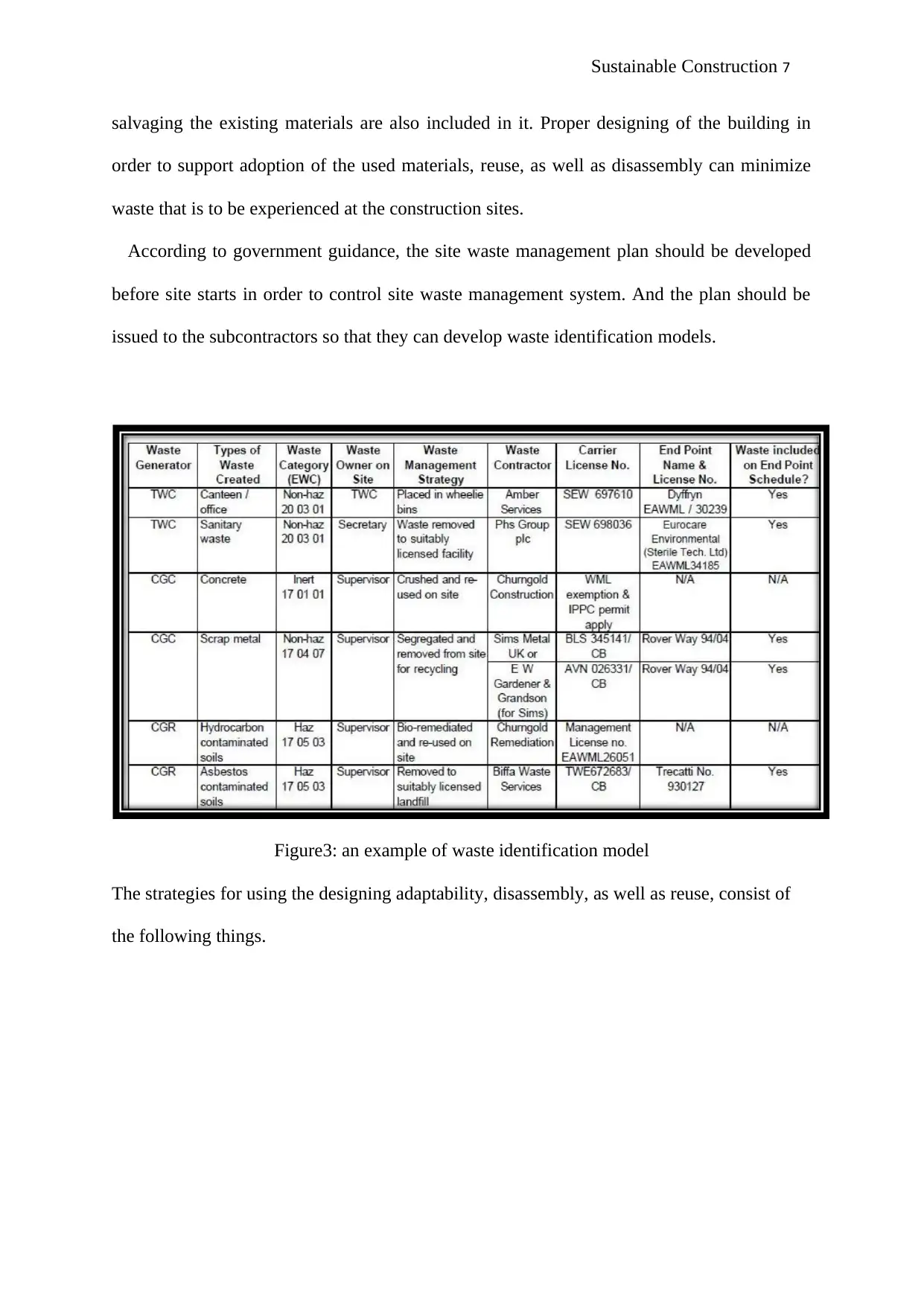
Sustainable Construction 7
salvaging the existing materials are also included in it. Proper designing of the building in
order to support adoption of the used materials, reuse, as well as disassembly can minimize
waste that is to be experienced at the construction sites.
According to government guidance, the site waste management plan should be developed
before site starts in order to control site waste management system. And the plan should be
issued to the subcontractors so that they can develop waste identification models.
Figure3: an example of waste identification model
The strategies for using the designing adaptability, disassembly, as well as reuse, consist of
the following things.
salvaging the existing materials are also included in it. Proper designing of the building in
order to support adoption of the used materials, reuse, as well as disassembly can minimize
waste that is to be experienced at the construction sites.
According to government guidance, the site waste management plan should be developed
before site starts in order to control site waste management system. And the plan should be
issued to the subcontractors so that they can develop waste identification models.
Figure3: an example of waste identification model
The strategies for using the designing adaptability, disassembly, as well as reuse, consist of
the following things.
Paraphrase This Document
Need a fresh take? Get an instant paraphrase of this document with our AI Paraphraser
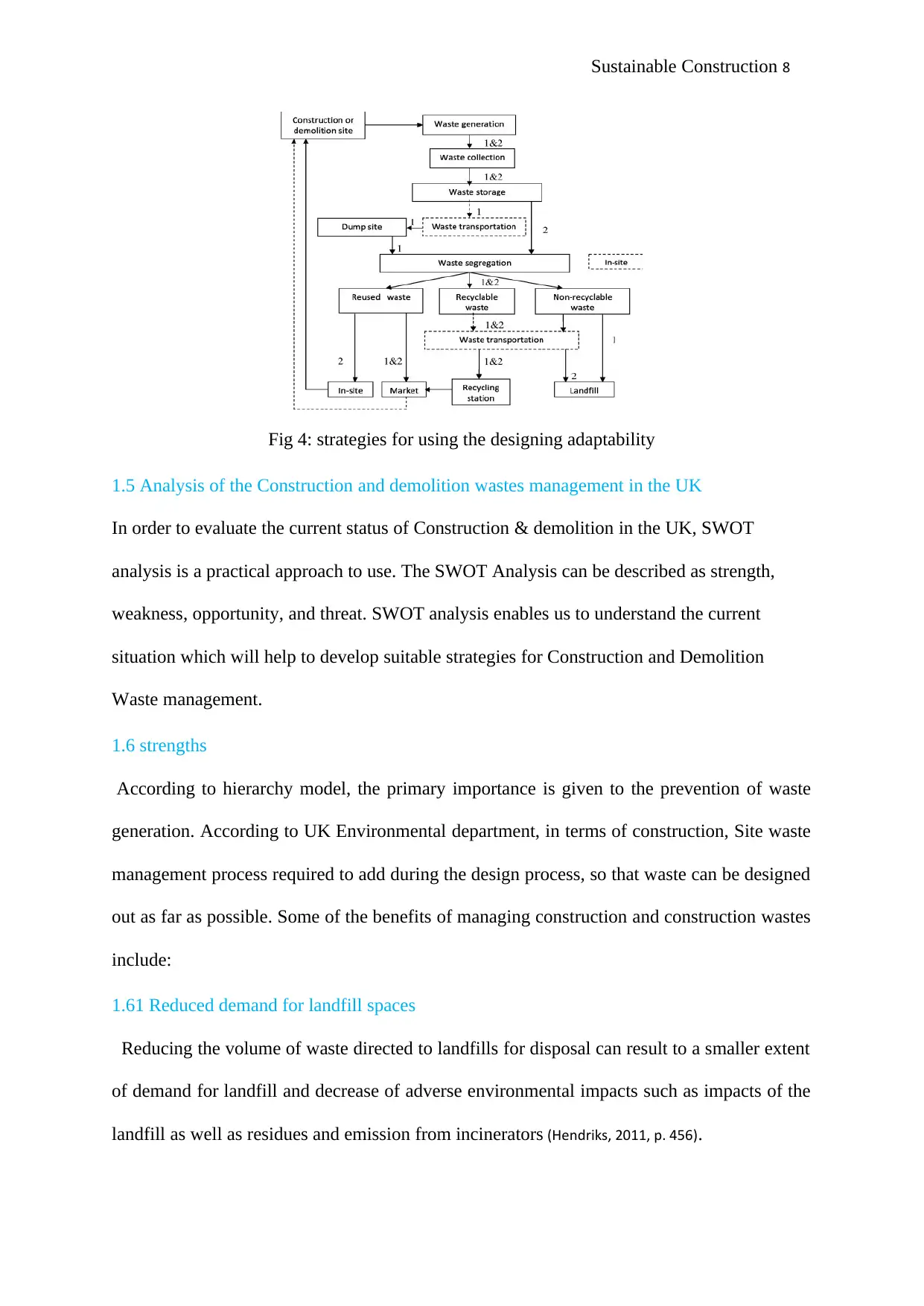
Sustainable Construction 8
Fig 4: strategies for using the designing adaptability
1.5 Analysis of the Construction and demolition wastes management in the UK
In order to evaluate the current status of Construction & demolition in the UK, SWOT
analysis is a practical approach to use. The SWOT Analysis can be described as strength,
weakness, opportunity, and threat. SWOT analysis enables us to understand the current
situation which will help to develop suitable strategies for Construction and Demolition
Waste management.
1.6 strengths
According to hierarchy model, the primary importance is given to the prevention of waste
generation. According to UK Environmental department, in terms of construction, Site waste
management process required to add during the design process, so that waste can be designed
out as far as possible. Some of the benefits of managing construction and construction wastes
include:
1.61 Reduced demand for landfill spaces
Reducing the volume of waste directed to landfills for disposal can result to a smaller extent
of demand for landfill and decrease of adverse environmental impacts such as impacts of the
landfill as well as residues and emission from incinerators (Hendriks, 2011, p. 456).
Fig 4: strategies for using the designing adaptability
1.5 Analysis of the Construction and demolition wastes management in the UK
In order to evaluate the current status of Construction & demolition in the UK, SWOT
analysis is a practical approach to use. The SWOT Analysis can be described as strength,
weakness, opportunity, and threat. SWOT analysis enables us to understand the current
situation which will help to develop suitable strategies for Construction and Demolition
Waste management.
1.6 strengths
According to hierarchy model, the primary importance is given to the prevention of waste
generation. According to UK Environmental department, in terms of construction, Site waste
management process required to add during the design process, so that waste can be designed
out as far as possible. Some of the benefits of managing construction and construction wastes
include:
1.61 Reduced demand for landfill spaces
Reducing the volume of waste directed to landfills for disposal can result to a smaller extent
of demand for landfill and decrease of adverse environmental impacts such as impacts of the
landfill as well as residues and emission from incinerators (Hendriks, 2011, p. 456).
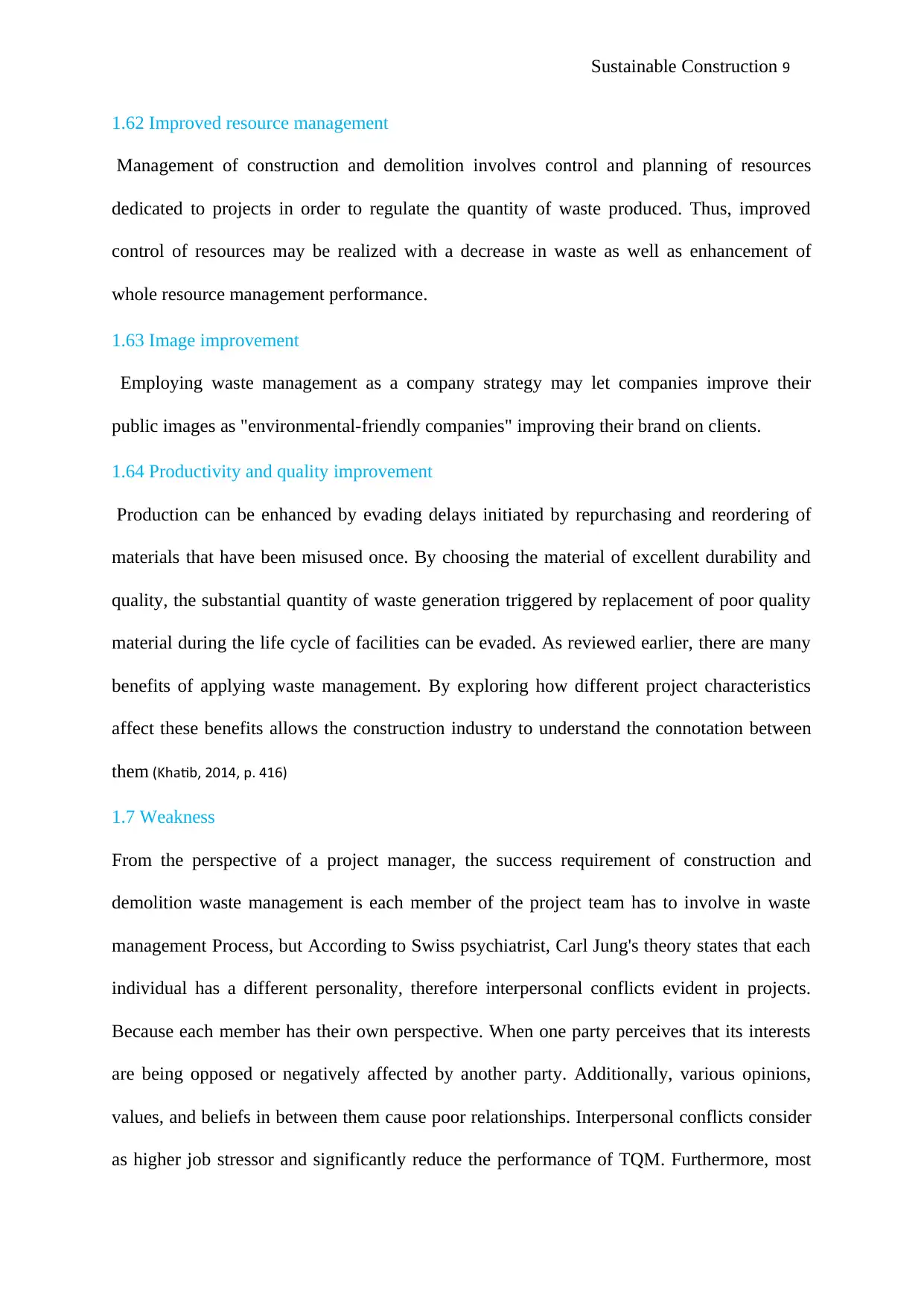
Sustainable Construction 9
1.62 Improved resource management
Management of construction and demolition involves control and planning of resources
dedicated to projects in order to regulate the quantity of waste produced. Thus, improved
control of resources may be realized with a decrease in waste as well as enhancement of
whole resource management performance.
1.63 Image improvement
Employing waste management as a company strategy may let companies improve their
public images as "environmental-friendly companies" improving their brand on clients.
1.64 Productivity and quality improvement
Production can be enhanced by evading delays initiated by repurchasing and reordering of
materials that have been misused once. By choosing the material of excellent durability and
quality, the substantial quantity of waste generation triggered by replacement of poor quality
material during the life cycle of facilities can be evaded. As reviewed earlier, there are many
benefits of applying waste management. By exploring how different project characteristics
affect these benefits allows the construction industry to understand the connotation between
them (Khatib, 2014, p. 416)
1.7 Weakness
From the perspective of a project manager, the success requirement of construction and
demolition waste management is each member of the project team has to involve in waste
management Process, but According to Swiss psychiatrist, Carl Jung's theory states that each
individual has a different personality, therefore interpersonal conflicts evident in projects.
Because each member has their own perspective. When one party perceives that its interests
are being opposed or negatively affected by another party. Additionally, various opinions,
values, and beliefs in between them cause poor relationships. Interpersonal conflicts consider
as higher job stressor and significantly reduce the performance of TQM. Furthermore, most
1.62 Improved resource management
Management of construction and demolition involves control and planning of resources
dedicated to projects in order to regulate the quantity of waste produced. Thus, improved
control of resources may be realized with a decrease in waste as well as enhancement of
whole resource management performance.
1.63 Image improvement
Employing waste management as a company strategy may let companies improve their
public images as "environmental-friendly companies" improving their brand on clients.
1.64 Productivity and quality improvement
Production can be enhanced by evading delays initiated by repurchasing and reordering of
materials that have been misused once. By choosing the material of excellent durability and
quality, the substantial quantity of waste generation triggered by replacement of poor quality
material during the life cycle of facilities can be evaded. As reviewed earlier, there are many
benefits of applying waste management. By exploring how different project characteristics
affect these benefits allows the construction industry to understand the connotation between
them (Khatib, 2014, p. 416)
1.7 Weakness
From the perspective of a project manager, the success requirement of construction and
demolition waste management is each member of the project team has to involve in waste
management Process, but According to Swiss psychiatrist, Carl Jung's theory states that each
individual has a different personality, therefore interpersonal conflicts evident in projects.
Because each member has their own perspective. When one party perceives that its interests
are being opposed or negatively affected by another party. Additionally, various opinions,
values, and beliefs in between them cause poor relationships. Interpersonal conflicts consider
as higher job stressor and significantly reduce the performance of TQM. Furthermore, most
⊘ This is a preview!⊘
Do you want full access?
Subscribe today to unlock all pages.

Trusted by 1+ million students worldwide
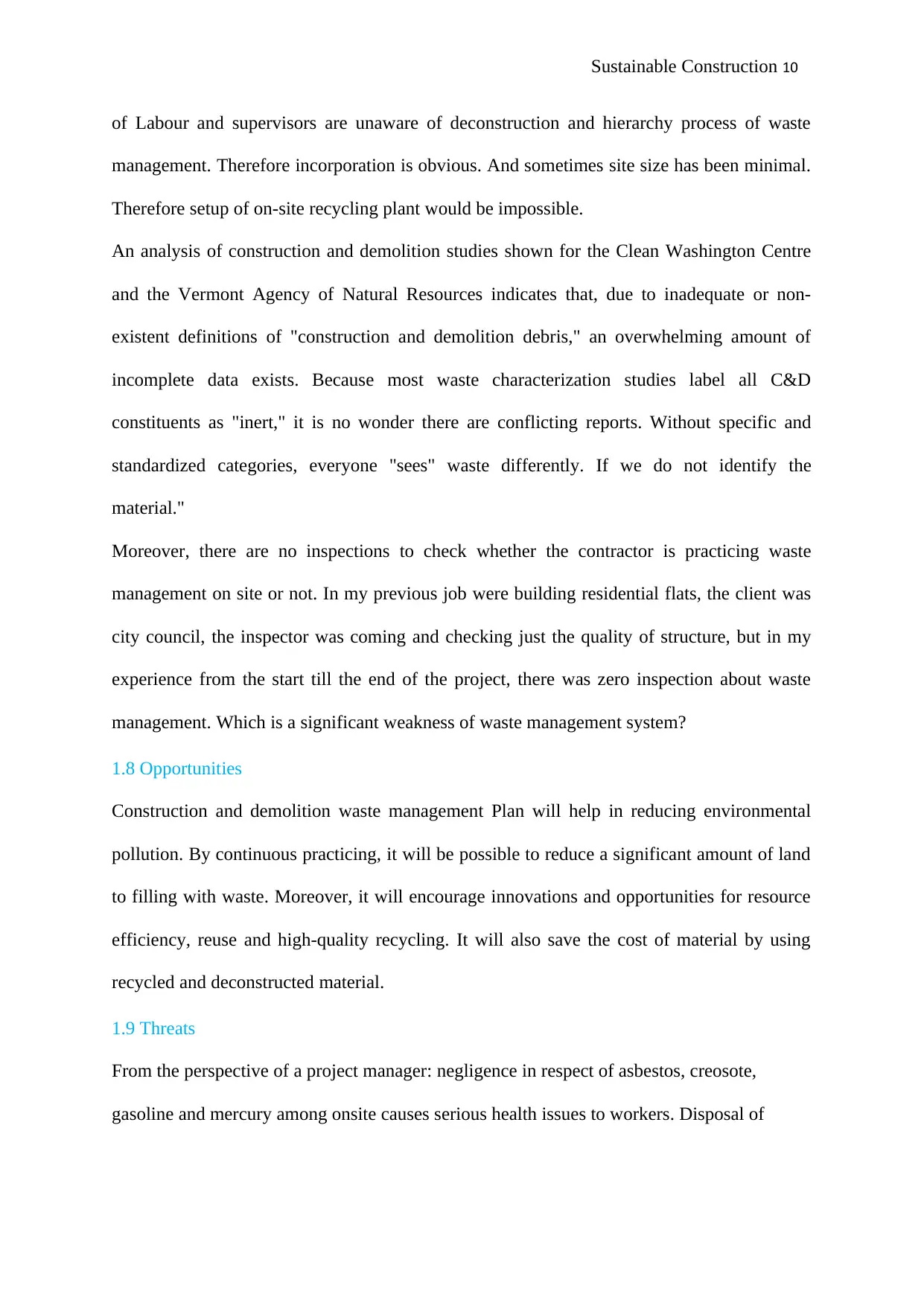
Sustainable Construction 10
of Labour and supervisors are unaware of deconstruction and hierarchy process of waste
management. Therefore incorporation is obvious. And sometimes site size has been minimal.
Therefore setup of on-site recycling plant would be impossible.
An analysis of construction and demolition studies shown for the Clean Washington Centre
and the Vermont Agency of Natural Resources indicates that, due to inadequate or non-
existent definitions of "construction and demolition debris," an overwhelming amount of
incomplete data exists. Because most waste characterization studies label all C&D
constituents as "inert," it is no wonder there are conflicting reports. Without specific and
standardized categories, everyone "sees" waste differently. If we do not identify the
material."
Moreover, there are no inspections to check whether the contractor is practicing waste
management on site or not. In my previous job were building residential flats, the client was
city council, the inspector was coming and checking just the quality of structure, but in my
experience from the start till the end of the project, there was zero inspection about waste
management. Which is a significant weakness of waste management system?
1.8 Opportunities
Construction and demolition waste management Plan will help in reducing environmental
pollution. By continuous practicing, it will be possible to reduce a significant amount of land
to filling with waste. Moreover, it will encourage innovations and opportunities for resource
efficiency, reuse and high-quality recycling. It will also save the cost of material by using
recycled and deconstructed material.
1.9 Threats
From the perspective of a project manager: negligence in respect of asbestos, creosote,
gasoline and mercury among onsite causes serious health issues to workers. Disposal of
of Labour and supervisors are unaware of deconstruction and hierarchy process of waste
management. Therefore incorporation is obvious. And sometimes site size has been minimal.
Therefore setup of on-site recycling plant would be impossible.
An analysis of construction and demolition studies shown for the Clean Washington Centre
and the Vermont Agency of Natural Resources indicates that, due to inadequate or non-
existent definitions of "construction and demolition debris," an overwhelming amount of
incomplete data exists. Because most waste characterization studies label all C&D
constituents as "inert," it is no wonder there are conflicting reports. Without specific and
standardized categories, everyone "sees" waste differently. If we do not identify the
material."
Moreover, there are no inspections to check whether the contractor is practicing waste
management on site or not. In my previous job were building residential flats, the client was
city council, the inspector was coming and checking just the quality of structure, but in my
experience from the start till the end of the project, there was zero inspection about waste
management. Which is a significant weakness of waste management system?
1.8 Opportunities
Construction and demolition waste management Plan will help in reducing environmental
pollution. By continuous practicing, it will be possible to reduce a significant amount of land
to filling with waste. Moreover, it will encourage innovations and opportunities for resource
efficiency, reuse and high-quality recycling. It will also save the cost of material by using
recycled and deconstructed material.
1.9 Threats
From the perspective of a project manager: negligence in respect of asbestos, creosote,
gasoline and mercury among onsite causes serious health issues to workers. Disposal of
Paraphrase This Document
Need a fresh take? Get an instant paraphrase of this document with our AI Paraphraser
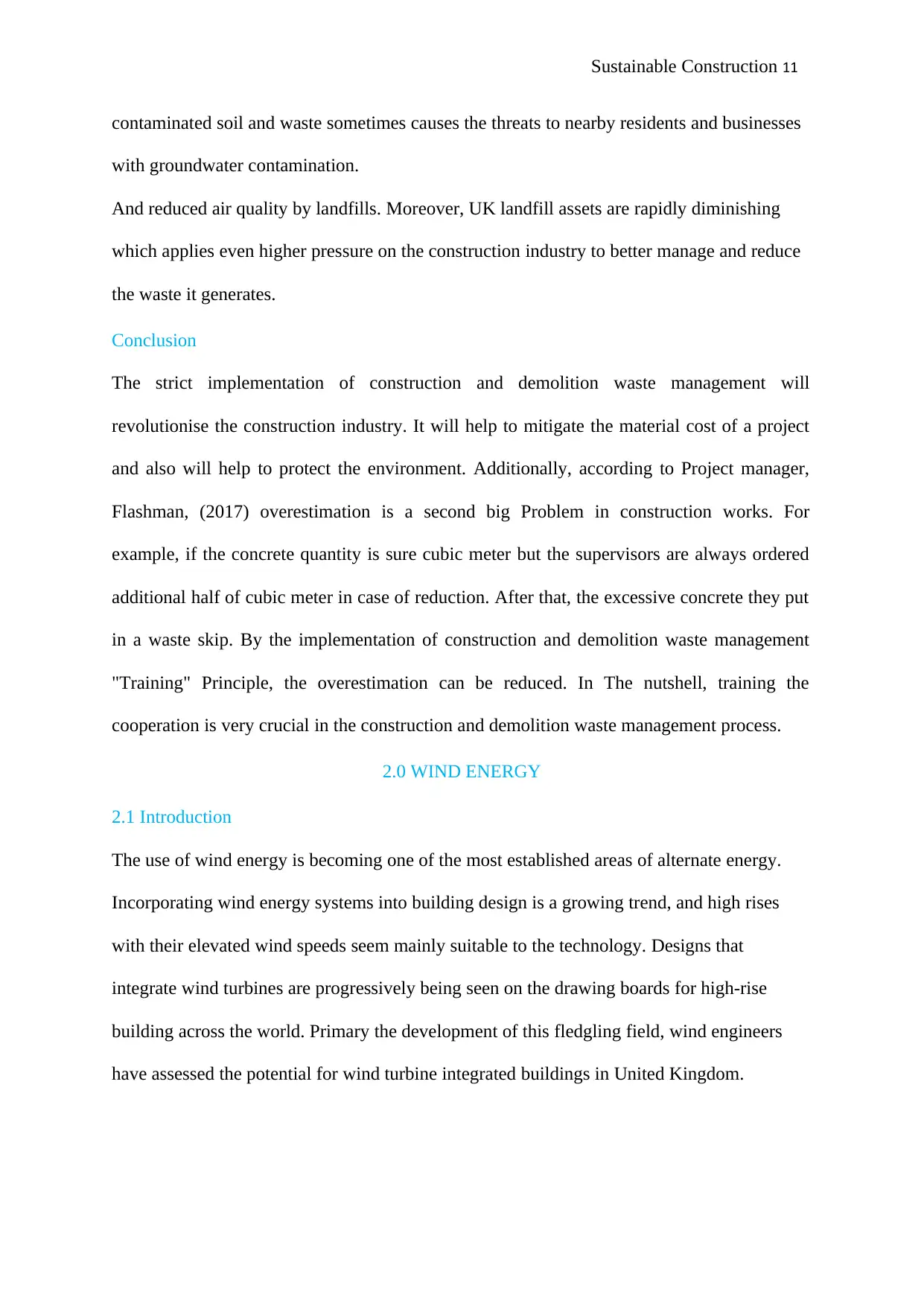
Sustainable Construction 11
contaminated soil and waste sometimes causes the threats to nearby residents and businesses
with groundwater contamination.
And reduced air quality by landfills. Moreover, UK landfill assets are rapidly diminishing
which applies even higher pressure on the construction industry to better manage and reduce
the waste it generates.
Conclusion
The strict implementation of construction and demolition waste management will
revolutionise the construction industry. It will help to mitigate the material cost of a project
and also will help to protect the environment. Additionally, according to Project manager,
Flashman, (2017) overestimation is a second big Problem in construction works. For
example, if the concrete quantity is sure cubic meter but the supervisors are always ordered
additional half of cubic meter in case of reduction. After that, the excessive concrete they put
in a waste skip. By the implementation of construction and demolition waste management
"Training" Principle, the overestimation can be reduced. In The nutshell, training the
cooperation is very crucial in the construction and demolition waste management process.
2.0 WIND ENERGY
2.1 Introduction
The use of wind energy is becoming one of the most established areas of alternate energy.
Incorporating wind energy systems into building design is a growing trend, and high rises
with their elevated wind speeds seem mainly suitable to the technology. Designs that
integrate wind turbines are progressively being seen on the drawing boards for high-rise
building across the world. Primary the development of this fledgling field, wind engineers
have assessed the potential for wind turbine integrated buildings in United Kingdom.
contaminated soil and waste sometimes causes the threats to nearby residents and businesses
with groundwater contamination.
And reduced air quality by landfills. Moreover, UK landfill assets are rapidly diminishing
which applies even higher pressure on the construction industry to better manage and reduce
the waste it generates.
Conclusion
The strict implementation of construction and demolition waste management will
revolutionise the construction industry. It will help to mitigate the material cost of a project
and also will help to protect the environment. Additionally, according to Project manager,
Flashman, (2017) overestimation is a second big Problem in construction works. For
example, if the concrete quantity is sure cubic meter but the supervisors are always ordered
additional half of cubic meter in case of reduction. After that, the excessive concrete they put
in a waste skip. By the implementation of construction and demolition waste management
"Training" Principle, the overestimation can be reduced. In The nutshell, training the
cooperation is very crucial in the construction and demolition waste management process.
2.0 WIND ENERGY
2.1 Introduction
The use of wind energy is becoming one of the most established areas of alternate energy.
Incorporating wind energy systems into building design is a growing trend, and high rises
with their elevated wind speeds seem mainly suitable to the technology. Designs that
integrate wind turbines are progressively being seen on the drawing boards for high-rise
building across the world. Primary the development of this fledgling field, wind engineers
have assessed the potential for wind turbine integrated buildings in United Kingdom.
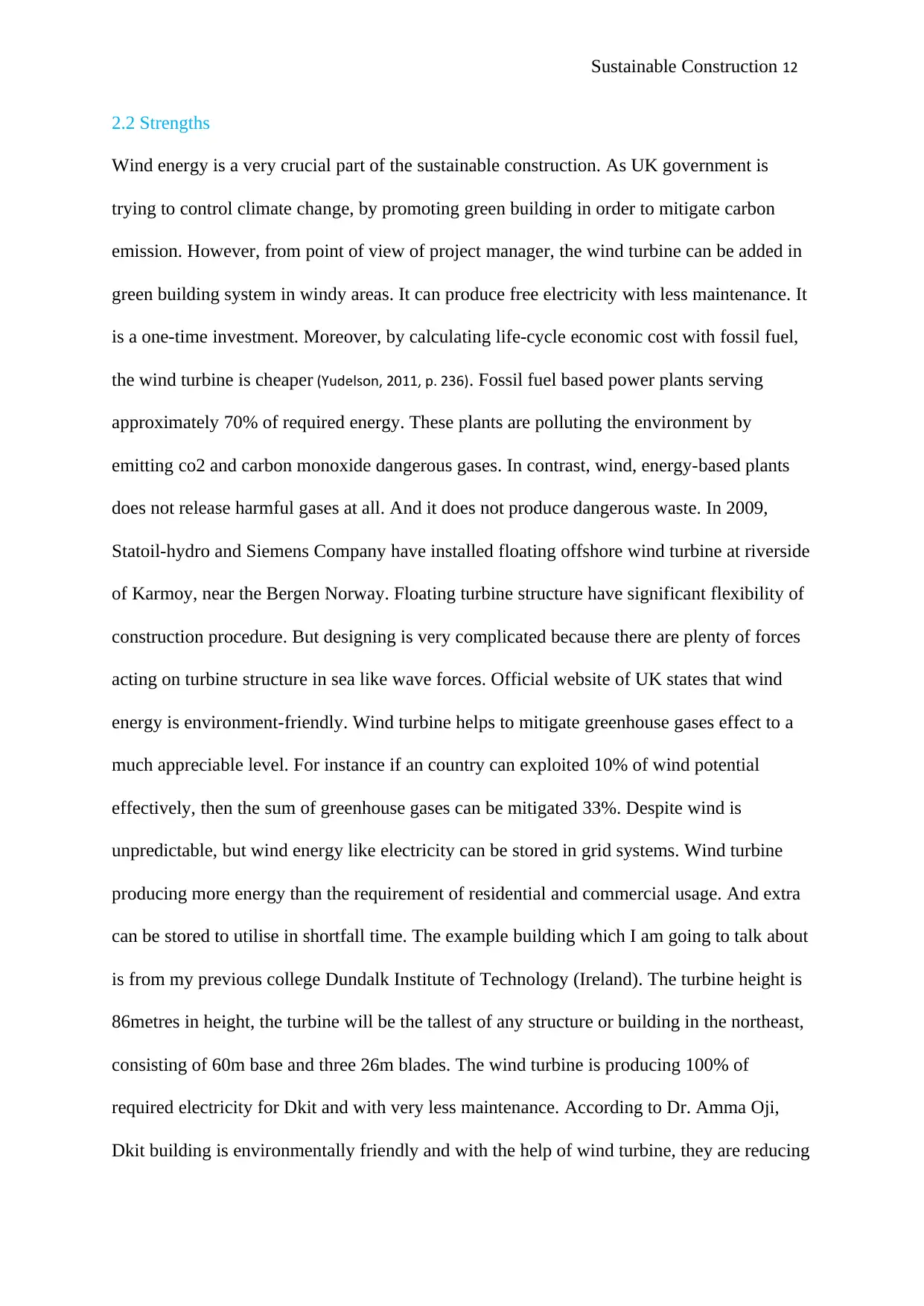
Sustainable Construction 12
2.2 Strengths
Wind energy is a very crucial part of the sustainable construction. As UK government is
trying to control climate change, by promoting green building in order to mitigate carbon
emission. However, from point of view of project manager, the wind turbine can be added in
green building system in windy areas. It can produce free electricity with less maintenance. It
is a one-time investment. Moreover, by calculating life-cycle economic cost with fossil fuel,
the wind turbine is cheaper (Yudelson, 2011, p. 236). Fossil fuel based power plants serving
approximately 70% of required energy. These plants are polluting the environment by
emitting co2 and carbon monoxide dangerous gases. In contrast, wind, energy-based plants
does not release harmful gases at all. And it does not produce dangerous waste. In 2009,
Statoil-hydro and Siemens Company have installed floating offshore wind turbine at riverside
of Karmoy, near the Bergen Norway. Floating turbine structure have significant flexibility of
construction procedure. But designing is very complicated because there are plenty of forces
acting on turbine structure in sea like wave forces. Official website of UK states that wind
energy is environment-friendly. Wind turbine helps to mitigate greenhouse gases effect to a
much appreciable level. For instance if an country can exploited 10% of wind potential
effectively, then the sum of greenhouse gases can be mitigated 33%. Despite wind is
unpredictable, but wind energy like electricity can be stored in grid systems. Wind turbine
producing more energy than the requirement of residential and commercial usage. And extra
can be stored to utilise in shortfall time. The example building which I am going to talk about
is from my previous college Dundalk Institute of Technology (Ireland). The turbine height is
86metres in height, the turbine will be the tallest of any structure or building in the northeast,
consisting of 60m base and three 26m blades. The wind turbine is producing 100% of
required electricity for Dkit and with very less maintenance. According to Dr. Amma Oji,
Dkit building is environmentally friendly and with the help of wind turbine, they are reducing
2.2 Strengths
Wind energy is a very crucial part of the sustainable construction. As UK government is
trying to control climate change, by promoting green building in order to mitigate carbon
emission. However, from point of view of project manager, the wind turbine can be added in
green building system in windy areas. It can produce free electricity with less maintenance. It
is a one-time investment. Moreover, by calculating life-cycle economic cost with fossil fuel,
the wind turbine is cheaper (Yudelson, 2011, p. 236). Fossil fuel based power plants serving
approximately 70% of required energy. These plants are polluting the environment by
emitting co2 and carbon monoxide dangerous gases. In contrast, wind, energy-based plants
does not release harmful gases at all. And it does not produce dangerous waste. In 2009,
Statoil-hydro and Siemens Company have installed floating offshore wind turbine at riverside
of Karmoy, near the Bergen Norway. Floating turbine structure have significant flexibility of
construction procedure. But designing is very complicated because there are plenty of forces
acting on turbine structure in sea like wave forces. Official website of UK states that wind
energy is environment-friendly. Wind turbine helps to mitigate greenhouse gases effect to a
much appreciable level. For instance if an country can exploited 10% of wind potential
effectively, then the sum of greenhouse gases can be mitigated 33%. Despite wind is
unpredictable, but wind energy like electricity can be stored in grid systems. Wind turbine
producing more energy than the requirement of residential and commercial usage. And extra
can be stored to utilise in shortfall time. The example building which I am going to talk about
is from my previous college Dundalk Institute of Technology (Ireland). The turbine height is
86metres in height, the turbine will be the tallest of any structure or building in the northeast,
consisting of 60m base and three 26m blades. The wind turbine is producing 100% of
required electricity for Dkit and with very less maintenance. According to Dr. Amma Oji,
Dkit building is environmentally friendly and with the help of wind turbine, they are reducing
⊘ This is a preview!⊘
Do you want full access?
Subscribe today to unlock all pages.

Trusted by 1+ million students worldwide
1 out of 21
Related Documents
Your All-in-One AI-Powered Toolkit for Academic Success.
+13062052269
info@desklib.com
Available 24*7 on WhatsApp / Email
![[object Object]](/_next/static/media/star-bottom.7253800d.svg)
Unlock your academic potential
Copyright © 2020–2025 A2Z Services. All Rights Reserved. Developed and managed by ZUCOL.




